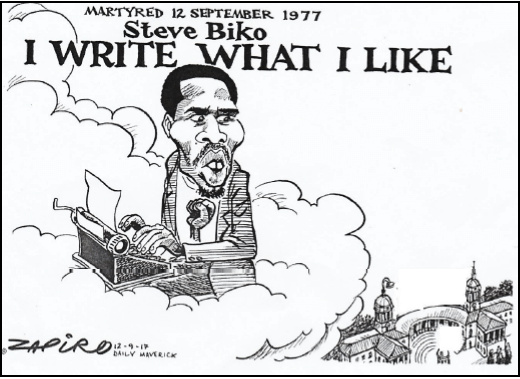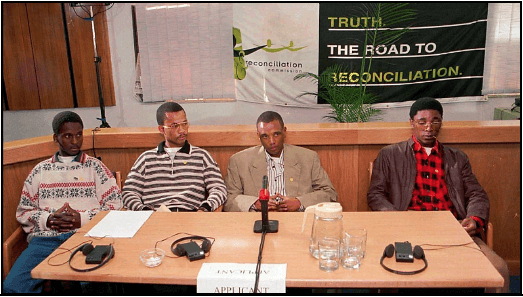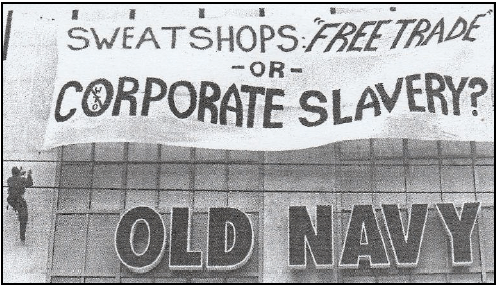History Paper 2 Grade 12 Addendum - NSC Past Papers And Memos September 2020 Preparatory Examinations
Share via Whatsapp Join our WhatsApp Group Join our Telegram GroupADDENDUM
QUESTION 1:
HOW DID THE PHILOSOPHY OF BLACK CONSCIOUSNESS (BC) INFLUENCE THE SOUTH AFRICAN YOUTH IN THE 1970s?
SOURCE 1A
This extract focuses on the meaning of the philosophy of Black Consciousness by Steve Biko in 1968.
Biko had a clear insight into the psychological aspect of the oppression of his time which resulted in momentary (brief) political impotence (weakness). As politics was racialised by apartheid, the movement was called Black Consciousness. His message was simple and clear: Do not be a part of your oppression. It was a crucial intervention, a fresh, youthful and distinctive voice that mobilised people when all the major political opposition was banned and their leaders were in exile or in jail. It provided a new, vital, unifying element to the ANC, as Wally Serote said, ‘oxygen and new life, which the movement desperately needed’. Black Consciousness worked with consensus decision-making. It instilled independent thinking, self-reliance, fearlessness and dignity. Biko and his contemporaries (colleagues) broke the stunned (shocked) silence of their time. The refusal of a new generation of young blacks to be subservient (obedient) or humiliated, even in the face of death, changed the nature of the struggle. Biko himself lived and died by this truth. A key catalyst (promoter) of transformation, Biko’s generation inspired a culture of fearlessness. |
[From Steve Biko by L. Wilson]
SOURCE 1B
The source below describes the influence of the Black Consciousness Movement on Veli Mbele who resided in Soweto in 1976.
I grew up in an environment in which many of my peers did not value their own lives and I consider myself fortunate to have encountered Black Consciousness at an early stage. Black Consciousness helped to transform my self-concept and self-esteem in a remarkable way. When I joined the Black Consciousness Movement, I was only 16. At the time the environment was not entirely friendly towards the BCM. Our belief in Black Consciousness was so strong we were not prepared to go into hiding purely because other forces had threatened to ‘deal’ with us or deny us employment if we didn’t abandon our political beliefs. This kind of reaction fortified (encouraged) us even more and we decided to spread the gospel of Black Consciousness even more vigorously (stronger). Thanks to Black Consciousness, many in my generation were transformed into young disciplined black men who through their community activism, earned the respect and admiration of their peers, families and the community. Ever since I came into contact with Black Consciousness, I have felt complete, content with who I am and most importantly, that I’m worthy of respect and dignity. |
[From We Write What We Like by C. Van Wyk]
SOURCE 1C
This extract focuses on the influence of the Black Consciousness Movement (BCM) on students in the 1970s.
In 1976 the Black Consciousness Movement (BCM) was very strong and black students were at the forefront of the struggle. Police arrested many student leaders and put them on trial. Through these political trials, the government wanted to show that the students were dangerous because they spread the ideas of Black Consciousness. The police said black consciousness made black people hate whites. In May, Steve got the chance to show that this was not true. He was called as a defence witness in the trial of nine young South African Student Organisation (SASO) students. A witness in a court of law can say things that are heard by everyone and reported all over the country. It was the first time Steve had spoken in public for three years. The whole world heard him talk about Black Consciousness. He showed that the movement was not trying to make black people hate whites. Black Consciousness wanted black people to be proud of their colour, not ashamed. The world listened carefully to what Steve said, but the South African government refused to listen. Anger in the township grew. On 16 June 1976 thousands of Sowetan students protested in the streets against the apartheid laws. The security forces opened fire and students were killed. |
[From Steve Biko by L. Price]
SOURCE 1D
This is a cartoon by Zapiro on commemorating Steve Biko and was published in the Daily Maverick on 19 September 2017.
[From Zapiro, Daily Maverick]
(Martyred – meaning tortured and killed)
QUESTION 2:
HOW SUCCESSFUL WAS THE TRUTH AND RECONCILIATION COMMISSION (TRC) IN DEALING WITH THE MURDER OF AMY BIEHL?
SOURCE 2A
This extract explains the reasons for the establishment of the TRC by the first democratically elected parliament in 1995.
In the year after the elections, Parliament’s Justice Portfolio Committee drafted legislation to establish a Truth and Reconciliation Commission (TRC). The seventeen- member Commission was given the task of establishing as complete a picture as possible of the causes, nature and extent of the gross violation of human rights violations committed in the period between 1 March 1960 and 1994 by conducting investigations and holding hearings. This period is seen as the most severe ‘crime against humanity’ by the apartheid regime. It also had to facilitate the granting of amnesty to persons who made full disclosure of all the relevant facts related to acts associated with a political objective. In addition, the Commission was required to restore the human and civil dignity of victims, recommend reparation measures and to compile a report of its findings and activities. They also had to recommend measures to prevent future violations of human rights. The Truth and Reconciliation Commission (TRC), as it was duly (accordingly) established, consisted of three committees. The first of these was the Human Rights Violation Committee, which had to look into the accounts of victims through hearings and investigations. The second was the Amnesty Committee, which had to evaluate amnesty applications. It had to apply the Norgard principles to determine whether an application qualified for amnesty. The third committee, the Reparation and Rehabilitation Committee, had to formulate a reparation policy to restore and rehabilitate the lives of victims and survivors of human rights violations. |
[From Country of my Skull by A. Krog]
SOURCE 2B
This source focuses on how and why Amy Biehl was murdered in Cape Town on the 25st August 1993.
Shortly before the end of the apartheid era, Amy Biehl was murdered. She was a victim of racial violence. Amy Biehl was white. She dedicated herself to ending apartheid in South Africa and was based at the University of the Western Cape and working in underprivileged communities. She also helped with voter registration in advance of the ‘Freedom Day’ elections. Amy knew Gugulethu and its people well, or thought she did. She was to be found in the township almost every day or night, could speak isiXhosa and do the phantsula. “That’s how much she fitted in here”, said Melanie Jacobs, the black woman who shared a house with Amy in Cape Town. “She loved Africa. She wasn’t just another white person”. On the evening of 25 August, 1993, Amy drove through Gugulethu township and fell prey (victim) to an angry group of black youths. They pelted (bombarded) Biehl’s car with rocks, forcing her to stop, then dragged her from her car and murdered her, yelling, ‘Kill the Settler!’. Her parents were informed that their daughter had been beaten and stabbed to death. Police arrested two teenage suspects, student members of a militant nationalist group, the Pan Africanist Congress, whose slogan is, ‘One settler, one bullet’. In Cape Town, the killing of the popular scholar has stirred a black backlash (reaction) against the militant group that promoted hatred for whites. The African National Congress offered its township network to help identify the killers. Friends and colleagues, after memorialising Miss Biehl with freedom songs, paraded through Gugulethu with placards declaring, ‘Comrades come in all colours’. |
[From https://www.nytimes.com1993/08/27/world/how-american- sister-died-in-atownship.html. Accessed on 1 September 2019.]
SOURCE 2C
This source focuses on the amnesty hearing of the murderers of Amy Biehl on the 8 July 1997 in Cape Town.
The four youths, Mzikhona Nofemela, Ntobeka Peni, Vusumzi Ntamo and Mongezi Manqina that were convicted of murdering Amy and given a prison sentence of eighteen years, applied for amnesty. The killers of Amy apologised to the parents for what a Truth Commission lawyer described as mindless savagery by a ‘pack of murderers’. The four Pan Africanist Congress (PAC) supporters were challenged on their claims before the Amnesty Committee that the mob killing was politically motivated. Biehl’s parents, Peter and Linda, shook hands with relatives of the four men at the start of the proceedings. In written affidavits submitted to the TRC’s Amnesty Committee, the four said they regretted the murder and asked Biehl’s parents for forgiveness. “I feel sorry and very down-hearted, especially today, realising the contribution Amy Biehl played in the struggle,” Peni said. However, he and his co- applicants insisted that the killing was politically motivated and inspired by the PAC’s slogan, ‘One settler, One bullet’. Peni testified Paso’s executive had ordered its members to make Gugulethu ungovernable and to assist the PAC’s armed wing, the Azanian People’s Liberation Army, in winning back black people’s land. “I regarded this as an instruction to also harm, injure and kill white people.” In 1998, Biehl’s killers were pardoned by the TRC (a decision the family endorsed) and released from prison after serving four years. The Biehls said they believe their daughter would have supported the Commission’s decision to grant amnesty. |
[From www.justice.gov.za/trc/media/1997/9707/s970708f.htm. Accessed on 1 September 2019.]
SOURCE 2D
This photograph shows the killers of Amy Biehl at the amnesty hearing on 8 July 1997 in Cape Town.
[From images amy biehl newpaper. jfif-photos. Accessed on 1 September 2019.]
QUESTION 3:
WHAT IMPACT DID MULTI-NATIONAL CORPORATIONS (MNC’s) HAVE ON GLOBAL CULTURES IN THE 1990s?
SOURCE 3A
The source below explains the meaning of globalisation.
| Globalisation is a process of interaction and integration among the people, companies and government of different nations, a process driven by international trade and investment and aided by information technology. This process has effects on the environment, on culture, political systems, economic development and prosperity and on human physical well-being in societies around the world. Globalisation is not new, though. For thousands of years, people and later corporations have been buying from and selling to each other in lands at great distances. Likewise, for centuries, people and corporations have invested in enterprises in other countries. Policy and technological developments of the past decades have spurred (encouraged) increases in cross-border trade, investment and migration so large that many observers believe the world has entered a qualitatively new phase in its economic development. Since 1950, for example, the volume of world trade has increased by 20 times; from 1997 to 1999 flows of foreign investment nearly doubled, from $468 billion to $827 billion. Distinguishing this current wave (trend) from earlier ones, author Thomas Friedman has said that today globalisation is, ‘faster, cheaper and deeper’. |
[From https://www.globalisation101.org>what-is-globalisation. Accessed on 17 September 2019.]
SOURCE 3B
This source describes the impact of globalisation on the cultures of developing countries.
| Globalisation has many benefits but is also detriment (disadvantage) to the culture in developing countries. Many developing countries’ cultures have been changed through globalisation and imitation others cultures such as America and European countries. Before globalisation it would not have been possible to know about other countries and their cultures. Due to important tools of globalisation like television, radio, satellite and internet, it is possible today to know what is happening in any other country. Moreover, people worldwide can know each other better through globalisation. Today we can clearly see the heavy effect that globalisation has on the young people in the different poor nations. It is very common to see teenagers wearing Nike T-shirts and sneakers, Adidas footwear, playing Hip-Hop music, using Apple iPad, eating at McDonalds, KFC and Domino’s Pizza. It looks like you can only distinguish them by their language. On the other hand, many developing countries are concerned about the rise of globalisation because it might lead to destruction of their own culture, traditions, identity, customs and their language. In many Arab countries, for example, some people wear and behave like developed nations, and only a few people wear their traditional clothes as they used to. Furthermore, globalisation leads to the disappearance of many words and expressions from local languages because many people use English. |
[From http://www.tigweb.org/youth-media/panorama/article.html?Contentl. Accessed on 10 September 2019.]
SOURCE 3C
The extract below describes how civil society protested against the multi-national company, ‘Nike’, in 1998.
| Nike, a leading sportswear manufacturer, is one of the business world’s shining examples of how to clean up an image. In the 1990s, the company was plagued (troubled) by reports that it used sweatshops and child labour. Pressure grew until 1998, when Nike co-founder Phil Knight publicly committed to changing the company’s practices, and Nike spent the next decade doing just that. Now, Nike’s sweatshop problem is threatening a comeback. On July 29, students and activists around the world participated in a day of protest against Nike, organised by United Students Against Sweatshops (USAS). The demonstrators, in cities such as Boston. Washington D.C., Bangalore and San Pedro Sula, represented an escalation of allegations against Nike that have been slowly bubbling (boiling) up. Among them are claims that workers at a Nike factory in Hansae, Vietnam, that suffered wage theft and verbal abuse and laboured for hours in temperatures well over the legal limit of 90 degrees, to the point that they would collapse at their sewing machines. Nike is also accused of cutting jobs at the Hansae factory and pulling production from a factory in Honduras with a strong union presence, resulting in hundreds of workers losing vital jobs. The company has also allegedly denied the independent monitoring group, Workers Rights Consortium (WRC) access to inspect its contract factories. |
[From https://qz.com/1042298/nike-is-facing-a-new-wave--of-anti-sweatshops-protest. Accessed on 10 September 2019.]
SOURCE 3D
This poster attacks giant corporations in 1998 in Washington D.C.
[From New Generation History by S. Govender et al]
ACKNOWLEDGEMENTS
Visual sources and other historical evidence were taken from the following:
Govender, S.et.al. 2007. New Generation History (New Generation Publishers)
http://www.tigweb.org/youth-media/panorama/article.html?Content
https://qz.com/1042298/nike-is-facing-a-new-wave--of-anti-sweatshops-protest
https://www.globalisation101.org>what-is-globalisation
https://www.nytimes.com1993/08/27/world/how-american- sister-died-in- atownship.html
images amy biehl newpaper. jfif-photos
Krog. A. 1999. Country of my Skull (Vintage Publishers)
Price, L. 2013. Steve Biko (Sached Books (Pty) Ltd)
Van Wyk, C. 2007. We Write What We Like (Wits University Press)
Wilson, L. 2011. Steve Biko (Jacana Media (Pty) Ltd)
www.justice.gov.za/trc/media/1997/9707/s970708f.htm
Zapiro, Daily Maverick